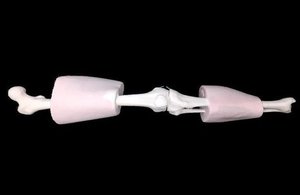3D printing synthetic bones for blast injury research
Case study from Imperial College London who pitched their ideas to industry and investors at the CDE Marketplace on 27 April 2016.

Lower limb frangible surrogate showing 3D printed bones and composite muscle constructs. Credit: Dr Andrew Phillips, Imperial College London.
Imperial College London were funded by the Centre for Defence Enterprise (CDE) to develop 3D-printed physical representations of lower limb bones, including realistic internal structures, for use in assessing blast injuries.
So far, individual 3D-printed lower limb nylon surrogates have been tested and found to fracture in a similar way to human bones. This could help improve research into assessing blast injury. Next steps for the project include the assessment of a wider range of materials for use in 3D printing, including composite materials, which may behave in an even more similar way to bone.
This development has the potential to eliminate the need for ethically controversial human cadaver material, while providing a more realistic injury response than can be achieved with non-breakable surrogates.
Dr Andrew Phillips, Imperial College London says:
CDE funding has allowed us to rapidly develop a research-based idea towards a product that has clear application in the assessment and mitigation of blast injury.
View the pitch presentation slides.
About CDE
CDE funds novel, high-risk, high-potential-benefit research. We work with the broadest possible range of science and technology providers, including academia and small companies, to develop cost-effective capabilities for UK armed forces and national security.
CDE is part of Dstl.
Centre for Defence Enterprise
Building R103
Fermi Avenue
Harwell Oxford
Oxfordshire
OX11 0QX
Please email for the quickest response.